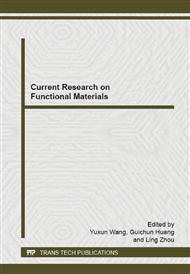[1]
J. Lekklala, P. Poramo, K. Nyholm, T. Kaikonen, EMF force sensor-a flexible and sensitive electret film for physiological application, Med. Bio. Eng. Comp. 34 (1996) 67-69.
Google Scholar
[2]
R. Gerhard-Multhaupt, Less can be more: holes in polymers lead to a new paradigm of piezoelectric materials for electret transducers, IEEE Trans. Dielectr. Insul. 9 (2002) 850-859.
DOI: 10.1109/tdei.2002.1038668
Google Scholar
[3]
S. Bauer, R. Gerhard-Multhaupt, G.M. Sessler, Ferroelectrets: soft electro-active foams for transducers, Phys. Today 57 (2) (2004) 37-43.
DOI: 10.1063/1.1688068
Google Scholar
[4]
S. Bauer, Piezo-, pyro- and ferroelectrets: soft transducer materials for electromechanical energy conversion, IEEE Trans. Dielectr. Insul. 5 (2006) 953-962.
DOI: 10.1109/tdei.2006.247819
Google Scholar
[5]
J. A. Rogers, T. Someya, Y. Huang, Materials and mechanics for stretchable electronics, Science, 327 (2010), 1603-1607.
DOI: 10.1126/science.1182383
Google Scholar
[6]
T. Sekitani, T. Someya, Stretchable, Large-area Organic Electronics, Adv. Mater. 22 (20) (2010), 2228-2246.
DOI: 10.1002/adma.200904054
Google Scholar
[7]
V. J. Lumelsky, M. S. Shur, S. Wagner, Sensitive skin, IEEE Sens. J. 41 (1) (2001), 1530-437X.
DOI: 10.1109/jsen.2001.923586
Google Scholar
[8]
X. Feng, Y. Hung, J. A. Rogers, Stretchable ferroelectric nano-ribbons with wavy configuration on elastomeric substrates, ACS Nano, 5 (2011), 3326-3332.
DOI: 10.1021/nn200477q
Google Scholar
[9]
Zhang. X, Pan. D, Wang. X, Cao. G, Sun. Z, Xia. Z, Piezoelectric coefficients of cross-linked polypropylene films stretched at elevated temperatures, Journal of Electrostatics 69 (6) (2011) 554-558.
DOI: 10.1016/j.elstat.2011.07.008
Google Scholar
[10]
X. Zhang, J. Huang, J. Chen, Z. Wan, S. Wang, and Z. Xia, Piezoelectric properties of irradiation-crosslinked polypropylene ferroelectrets, Appl. Phys. Lett. 91 (2007), 182901.
DOI: 10.1063/1.2803316
Google Scholar
[11]
X. Zhang, X. Wang, J. Huang, and Z. Xia, Quasi-static and dynamic piezoelectric d33 coefficients of irradiation cross-linked polypropylene ferroelectrets, J. Materials Sci., 44 (2009) 2459-2465.
DOI: 10.1007/s10853-009-3312-3
Google Scholar
[12]
Xiaoqing Zhang, Xinwu Zhang, Qiong You, Gerhard M. Sessler, Low cost, large area, stretchable piezoelectric films based on irradiation cross-linked polypropylene, Macromol. Mater. Eng. 299 (2014) 290–295.
DOI: 10.1002/mame.201300161
Google Scholar
[13]
G.S. Neugschwandtner, R. Schwödiauer, M. Vieytes, S. Bauer-Gogonea, S. Bauer, J. Hillenbrand, R. Kressmann, G.M. Sessler, M. Paajanen, J. Lekkala, Large and broadband piezoelectricity in smart polymer-foam space-charge electrets, Appl. Phys. Lett. 77 (2000).
DOI: 10.1063/1.1331348
Google Scholar
[14]
A. Mellinger, Dielectric resonance spectroscopy: a versatile tool in the quest for better piezoelectric polymers, IEEE Trans. Dielectr. Electr. Insul 10 (2003) 842-861.
DOI: 10.1109/tdei.2003.1237333
Google Scholar
[15]
IEEE standard on piezoelectricity, ANSI/IEEE Std. 176, (1987).
Google Scholar
[16]
A.K. Jonscher, Dielectric Relaxation in Solids. Chelsea Dielectrics Press, London, (1983).
Google Scholar
[17]
S. Havriliak, S.J. Havriliak, Dielectric and Mechanical Relaxation in Materials. Hanser, Munich, (1997).
Google Scholar
[18]
A.K. Jonscher, Dielectric relaxation in solids, J. Phys. D: Appl. Phys. 32 (1999) R57-R70.
DOI: 10.1088/0022-3727/32/14/201
Google Scholar
[19]
David I. Bower, An Introduction to Polymer Physics, Cambridge University Press, (2002).
Google Scholar
[20]
X. Zhang, G.M. Sessler, J. Hillenbrand, Improvement of piezoelectric coefficientof cellular polypropylenefilms by repeated expansions, J. Electrost 65 (2007)94-100.
DOI: 10.1016/j.elstat.2006.07.006
Google Scholar
[21]
Xinwu. Zhang, Xiaoqing. Zhang, Piezoelectric and acoustic behavior of polypropylenepiezoelectret Films, Acta Physica Sinica 16(2013) 167702.
Google Scholar


